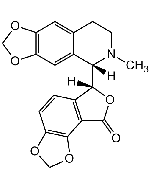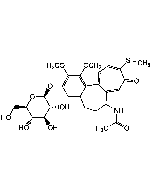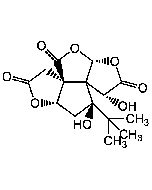Cookie Policy: This site uses cookies to improve your experience. You can find out more about our use of cookies in our Privacy Policy. By continuing to browse this site you agree to our use of cookies.
Chemodex
GABA

| Product Details | |
|---|---|
| Synonyms | 4-Aminobutanoic acid; Piperidic acid; Piperidinic acid; γ-Aminobutyric acid |
| Product Type | Chemical |
| Properties | |
| Formula | C4H9NO2 |
| MW | 103.12 |
| CAS | 56-12-2 |
| Purity Chemicals | ≥99% (Titration) |
| Appearance | White crystals or crystalline powder. |
| Solubility | Soluble in water. |
| Identity | Determined by NMR. |
| Declaration | Manufactured by Chemodex. |
| Other Product Data |
Click here for Original Manufacturer Product Datasheet |
| InChi Key | BTCSSZJGUNDROE-UHFFFAOYSA-N |
| Smiles | OC(CCCN)=O |
| Shipping and Handling | |
| Shipping | AMBIENT |
| Short Term Storage | +20°C |
| Long Term Storage | +20°C |
| Handling Advice | Protect from light and moisture. |
| Use/Stability | Stable for at least 2 years after receipt when stored at +20°C. |
| Documents | |
| Product Specification Sheet | |
| Datasheet |
 Download PDF Download PDF |
An amino acid that functions as the major inhibitory neurotransmitter in the mammalian central nervous system and also functions as a neuromodulator in some peripheral tissues. GABAA and GABAB receptor agonist that increases Cl− conductance. GABA acts at inhibitory synapses in the brain by binding to specific transmembrane receptors in the plasma membrane of both pre- and postsynaptic neuronal processes. This binding causes the opening of ion channels to allow the flow of either negatively charged chloride ions into the cell or positively charged potassium ions out of the cell. This action results in a negative change in the transmembrane potential, usually causing hyperpolarization. GABAergic neurons are involved in myorelaxation, anxiolytic treatment, sedation and anaesthetics. GABA can also influence heart rate and blood pressure and function as a immunomodulator.
(1) H.A. Al-Wadei, et al.; Mol. Nutr. Food Res. 55, 1745 (2011) | (2) Z. Jin, et al.; Amino Acids 45, 87 (2013) | (3) C.A. Huebner & K. Holthoff; Front. Cell Neurosci. 7, 177 (2013) | (4) T. Crowley, et al.; Brain Behav. Immun. 54, 260 (2016) | (5) N.X. Tritsch, et al.; Nat. Rev. Neurosci. 17, 139 (2016) | (6) R. Mazzoli & E. Pessione; Front. Microbiol. 7, 1934 (2016)










